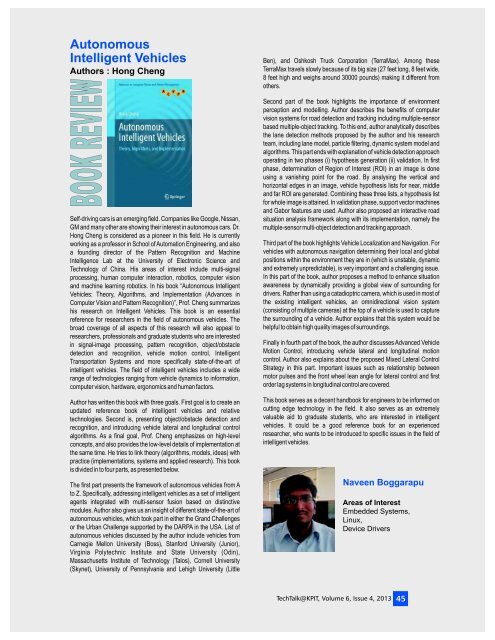Autonomous Vehicles - KPIT
Autonomous Vehicles - KPIT
Autonomous Vehicles - KPIT
Create successful ePaper yourself
Turn your PDF publications into a flip-book with our unique Google optimized e-Paper software.
<strong>Autonomous</strong><br />
Intelligent <strong>Vehicles</strong><br />
Authors : Hong Cheng<br />
BOOK REVIEW<br />
Self-driving cars is an emerging field. Companies like Google, Nissan,<br />
GM and many other are showing their interest in autonomous cars. Dr.<br />
Hong Cheng is considered as a pioneer in this field. He is currently<br />
working as a professor in School of Automation Engineering, and also<br />
a founding director of the Pattern Recognition and Machine<br />
Intelligence Lab at the University of Electronic Science and<br />
Technology of China. His areas of interest include multi-signal<br />
processing, human computer interaction, robotics, computer vision<br />
and machine learning robotics. In his book “<strong>Autonomous</strong> Intelligent<br />
<strong>Vehicles</strong>: Theory, Algorithms, and Implementation (Advances in<br />
Computer Vision and Pattern Recognition)”, Prof. Cheng summarizes<br />
his research on Intelligent <strong>Vehicles</strong>. This book is an essential<br />
reference for researchers in the field of autonomous vehicles. The<br />
broad coverage of all aspects of this research will also appeal to<br />
researchers, professionals and graduate students who are interested<br />
in signal-image processing, pattern recognition, object/obstacle<br />
detection and recognition, vehicle motion control, Intelligent<br />
Transportation Systems and more specifically state-of-the-art of<br />
intelligent vehicles. The field of intelligent vehicles includes a wide<br />
range of technologies ranging from vehicle dynamics to information,<br />
computer vision, hardware, ergonomics and human factors.<br />
Author has written this book with three goals. First goal is to create an<br />
updated reference book of intelligent vehicles and relative<br />
technologies. Second is, presenting object/obstacle detection and<br />
recognition, and introducing vehicle lateral and longitudinal control<br />
algorithms. As a final goal, Prof. Cheng emphasizes on high-level<br />
concepts, and also provides the low-level details of implementation at<br />
the same time. He tries to link theory (algorithms, models, ideas) with<br />
practice (implementations, systems and applied research). This book<br />
is divided in to four parts, as presented below.<br />
The first part presents the framework of autonomous vehicles from A<br />
to Z. Specifically, addressing intelligent vehicles as a set of intelligent<br />
agents integrated with multi-sensor fusion based on distinctive<br />
modules. Author also gives us an insight of different state-of-the-art of<br />
autonomous vehicles, which took part in either the Grand Challenges<br />
or the Urban Challenge supported by the DARPA in the USA. List of<br />
autonomous vehicles discussed by the author include vehicles from<br />
Carnegie Mellon University (Boss), Stanford University (Junior),<br />
Virginia Polytechnic Institute and State University (Odin),<br />
Massachusetts Institute of Technology (Talos), Cornell University<br />
(Skynet), University of Pennsylvania and Lehigh University (Little<br />
Ben), and Oshkosh Truck Corporation (TerraMax). Among these<br />
TerraMax travels slowly because of its big size (27 feet long, 8 feet wide,<br />
8 feet high and weighs around 30000 pounds) making it different from<br />
others.<br />
Second part of the book highlights the importance of environment<br />
perception and modelling. Author describes the benefits of computer<br />
vision systems for road detection and tracking including multiple-sensor<br />
based multiple-object tracking. To this end, author analytically describes<br />
the lane detection methods proposed by the author and his research<br />
team, including lane model, particle filtering, dynamic system model and<br />
algorithms. This part ends with explanation of vehicle detection approach<br />
operating in two phases (i) hypothesis generation (ii) validation. In first<br />
phase, determination of Region of Interest (ROI) in an image is done<br />
using a vanishing point for the road. By analysing the vertical and<br />
horizontal edges in an image, vehicle hypothesis lists for near, middle<br />
and far ROI are generated. Combining these three lists, a hypothesis list<br />
for whole image is attained. In validation phase, support vector machines<br />
and Gabor features are used. Author also proposed an interactive road<br />
situation analysis framework along with its implementation, namely the<br />
multiple-sensor multi-object detection and tracking approach.<br />
Third part of the book highlights Vehicle Localization and Navigation. For<br />
vehicles with autonomous navigation determining their local and global<br />
positions within the environment they are in (which is unstable, dynamic<br />
and extremely unpredictable), is very important and a challenging issue.<br />
In this part of the book, author proposes a method to enhance situation<br />
awareness by dynamically providing a global view of surrounding for<br />
drivers. Rather than using a catadioptric camera, which is used in most of<br />
the existing intelligent vehicles, an omnidirectional vision system<br />
(consisting of multiple cameras) at the top of a vehicle is used to capture<br />
the surrounding of a vehicle. Author explains that this system would be<br />
helpful to obtain high quality images of surroundings.<br />
Finally in fourth part of the book, the author discusses Advanced Vehicle<br />
Motion Control, introducing vehicle lateral and longitudinal motion<br />
control. Author also explains about the proposed Mixed Lateral Control<br />
Strategy in this part. Important issues such as relationship between<br />
motor pulses and the front wheel lean angle for lateral control and first<br />
order lag systems in longitudinal control are covered.<br />
This book serves as a decent handbook for engineers to be informed on<br />
cutting edge technology in the field. It also serves as an extremely<br />
valuable aid to graduate students, who are interested in intelligent<br />
vehicles. It could be a good reference book for an experienced<br />
researcher, who wants to be introduced to specific issues in the field of<br />
intelligent vehicles.<br />
Naveen Boggarapu<br />
Areas of Interest<br />
Embedded Systems,<br />
Linux,<br />
Device Drivers<br />
TechTalk@<strong>KPIT</strong>, Volume 6, Issue 4, 2013 545


